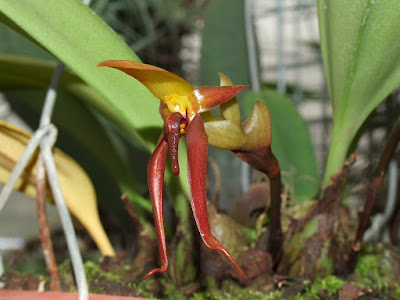Bulbophyllum levanae is native to Philippines. This orchid is found on the island of Panay in the provinces of Antique and Capiz, on the island of Luzon in the provinces of Rizal, Sorsogon and Zambales and on the islands of Leyte and Sibuyan. They grow in forests at an altitude of 500 m.
Bulbophyllum levanae, also called as Levan's Bulbophyllum (named after the Swedish botanist Albert Levan), Bulbophyllum levanae var. giganteum is a species of the genus Bulbophyllum. This species was described by Ames in 1915.
IDENTIFY BULBOPHYLLUM LEVANAE
Bulbophyllum levanae is native to Philippines. This orchid is found on the island of Panay in the provinces of Antique and Capiz, on the island of Luzon in the provinces of Rizal, Sorsogon and Zambales and on the islands of Leyte and Sibuyan. They grow in forests at an altitude of 500 m.
It is a small sized, unifoliate epiphyte with close set, pear-shaped, erect to ascending pseudobulbs (2-3 cm long and 1.5-2.0 cm in diameter) carrying a single, apical, leathery, oblong, gradually narrowing below into the rigid petiolate base leaf which are up to 22 cm long and 3-4 cm wide..
Levan's Bulbophyllum blooms on a basal, ascending, 4" (10 cm) long, successively opening, 2 to 3 flowered inflorescence with pale yellow flowers, a brown lip, an unpleasant odor. Upper sepals are oblong-lanceolate with a narrow pointed tip. The lateral sepals are long, triangular, tapering toward the apex.
BULBOPHYLLUM LEVANAE CARE AND CULTURE
Cultural information should only be used as a guide, and should be to be adapted to suit you. Your physical location; where you grow your plants, how much time you have to devote to their care, and many other factors, will need to be taken into account. Only then can you decide on the cultural methods that best suit you and your plants.
Light:
Bulbophyllum levanae needs a light level of 12000-23000 lux. The light should be filtered or dispersed, and the plants should not be exposed directly to the sun in the afternoon hours. Strong air movement should be ensured all the time.
Temperature:
It is a thermophilic plant. Throughout the year, the average day temperature is 26-29 ° C, and the average night temperature is 20-23 ° C, with a daily amplitude of 6-7 ° C.
Humidity:
Levan's Bulbophyllum needs a humidity of 80-85% for most of the year, only for one spring month the humidity falls to 75%.
Substrate, growing media:
Bulbophyllum levanae grow well attached to pieces of tree ferns or cork, as long as they can provide high humidity, which requires daily watering during the summer. These plants require constant moisture, but excellent drainage and good access to the roots must be ensured. These plants can also grow in baskets filled with loose, quickly draining soil that does not decompose too quickly. Tree fern fibers are the favorite for many substrates because they do not decompose so quickly, like bark.
Repotting:
This species react very badly to any violations of the root ball. After dividing or repotting, the plants often return to their normal condition for about a year. If the substrate has not decomposed, but the plant has grown out of the container, you can move the plant with the whole root ball to a larger basket or pot without disturbing the roots. If repotting is necessary, it is best to carry it out when the new roots are already beginning to grow, to allow the plant to root as quickly as possible. Plants should, however, be repotted immediately after finding out that the substrate has decomposed and does not discharge water quickly enough.
Watering:
From the end of spring to autumn, Bulbophyllum levanae should be watered abundantly. However, care should be taken that the substrate is not soaked or damp. In late autumn, watering should be gradually reduced.
Fertilizer:
During the period of active growth, 1/4-1/2 of the recommended fertilizer dose for orchids is fed weekly. It is possible to apply a balanced fertilizer all year round, and it is possible to use fertilizer with an increased nitrogen content from spring to mid-summer, and with increased phosphorus content in late summer and autumn.
Rest period:
From late winter to the beginning of spring, water need to be reduced. Bulbophyllum levanae should be allowed to lightly dry between waterings, but they should not completely dry out or remain without water. In most cases, a sufficient amount of water will provide quite regular fogging in the early morning between rare watering. This will prevent the plant from drying completely and provide it with the slight rest necessary to induce flowering. Fertilization should be reduced until more intense watering starts in the spring.















COMMENTS